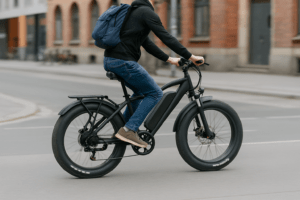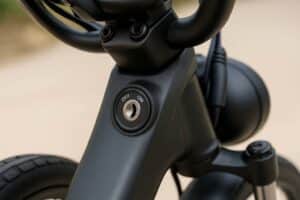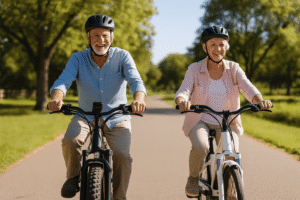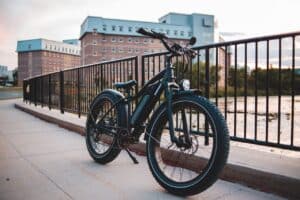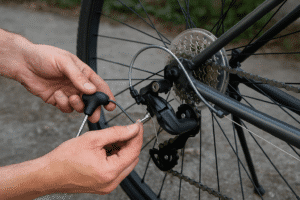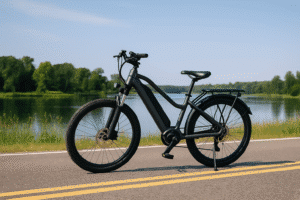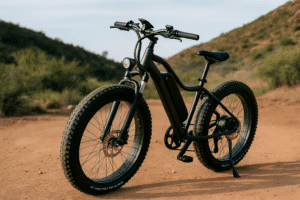Electric bikes are legal in Virginia, but there are specific rules depending on the class of e-bike you ride.
Virginia uses a 3-class system that sets limits on speed, motor power, and where you can ride. Knowing these rules will help you stay safe, avoid fines, and ride confidently.
Virginia E-Bike Laws at a Glance:
- Virginia uses the Class 1, Class 2, and Class 3 e-bike system.
- All e-bikes must have operable pedals, a motor rated at 1,000 watts or less, and a top assisted speed of 25 mph or lower.
- No license, registration, or insurance is required for e-bikes that meet the legal definition.
- Riders of Class 1 and Class 2 e-bikes have no minimum age requirement.
- Riders of Class 3 e-bikes must be 14 years or older.
- Helmets are required for all Class 3 riders and passengers, and recommended for every rider.
- E-bikes are generally allowed on roads, bike lanes, and shared-use paths, but localities may restrict access for certain classes.
- Throttles are allowed on Class 2 e-bikes but must cut off at 20 mph.
Are E-Bikes Legal in Virginia?
Yes. E-bikes are legal in Virginia and are generally treated the same as regular bicycles. You can ride them on most streets, bike lanes, and shared-use paths, but Class 3 e-bikes have additional restrictions.
According to § 46.2-904.1 of the Code of Virginia, an e-bike must have operable pedals, a motor rated at 1,000 watts or less, and a motor that stops providing assistance when you stop pedaling or use the brakes.
The bike also cannot exceed 25 mph with motor assistance.
If your e-bike meets these standards, you can ride it without a driver’s license, registration, or insurance.
However, local governments may set their own rules for certain paths and trails, and some areas restrict Class 3 e-bikes from bike paths or prohibit e-bikes entirely on specific natural-surface trails.
Virginia E-Bike Definition and Requirements
Virginia defines an electric power-assisted bicycle as a vehicle with fully operable pedals and an electric motor that meets these rules:
- Motor power is 1,000 watts or less.
- Maximum assisted speed is 25 mph.
- The motor stops when you stop pedaling or use the brakes.
- Meets U.S. Consumer Product Safety Commission bicycle equipment standards.
- Has a permanent label showing its class, top assisted speed, and motor wattage.
If your bike does not meet these standards, it may be classified as a moped or motor vehicle, which means stricter rules apply.
E-bikes that follow Virginia’s definition are not subject to licensing, registration, or insurance.
Virginia’s 3 E-Bike Classes Explained
Virginia uses the same 3-class system found in most U.S. states. The class determines how fast your bike can go with assistance and where you can ride it.
- Class 1: Pedal-assist only. Motor provides assistance up to 20 mph and stops when you stop pedaling.
- Class 2: Throttle or pedal-assist. Motor can propel the bike without pedaling, up to 20 mph.
- Class 3: Pedal-assist only. Motor assists up to 28 mph, must have a speedometer, and riders must be at least 14 years old and wear a helmet.
Where Can You Ride an E-Bike in Virginia?
You can ride an e-bike in Virginia anywhere regular bicycles are allowed, including streets, bike lanes, and most shared-use paths. However, Class 3 e-bikes face more restrictions and may be banned from certain trails or bike paths. Local governments can also set additional rules.
Allowed On:
- Public streets, highways, and roads
- Bike lanes along roads
- Shared-use paths (Class 1 and Class 2, unless locally restricted)
- Most paved trails and urban paths where bicycles are permitted
Not Allowed On:
- Some bike paths for Class 3 e-bikes (depending on local ordinances)
- Natural-surface trails designated as non-motorized
- Any restricted areas posted by local authorities or park management
Age and Helmet Rules
In Virginia, there is no minimum age requirement for riding Class 1 or Class 2 e-bikes. Riders of Class 3 e-bikes must be at least 14 years old.
Helmets are required by law for all operators and passengers of Class 3 e-bikes. While helmets are not legally required for Class 1 and 2 riders, wearing one is strongly recommended for safety. Local jurisdictions may also impose their own helmet rules for other classes.
These laws aim to reduce serious head injuries, especially since Class 3 bikes can reach higher speeds. Even if the law does not require it, a helmet can be the single most effective safety gear you wear.
Do You Need a License or Registration?
You do not need a driver’s license, registration, or insurance to ride an e-bike in Virginia. E-bikes that meet the state’s definition are treated like bicycles for legal purposes.
This makes e-bikes far more accessible compared to mopeds or motorcycles, which require licensing and registration.
As long as your e-bike meets Virginia’s requirements for motor power, speed, and equipment, you can ride it without extra paperwork.
However, modifying your bike to exceed these limits could change its classification and make it subject to moped or motor vehicle rules.
Read more:
E-Bikes in Virginia State Parks and Forests
Virginia allows e-bikes in many state parks and forests, but rules vary depending on the trail type and class of e-bike. Class 1 and Class 2 e-bikes are generally permitted where bicycles are allowed, while Class 3 bikes may be restricted.
Common park guidelines include:
- Class 1 and 2 allowed on most paved and gravel multi-use trails
- Class 3 often limited to roadways and certain designated trails
- Natural-surface trails may prohibit all e-bikes
- Always check park-specific rules before visiting
Safety Tips for Riding an E-Bike in Virginia
Riding safely protects you and others, especially in busy urban areas or on shared trails.
- Always obey traffic signals and stop signs
- Ride with the flow of traffic, not against it
- Use lights and reflectors when riding at night or in low visibility
- Wear a properly fitted helmet, even if not legally required
- Maintain a safe speed, especially around pedestrians or other cyclists
- Signal your turns and lane changes clearly
- Keep your e-bike in good working condition, especially brakes and tires
Final Words
Virginia’s e-bike laws are straightforward if you know your bike’s class and follow local rules. Class 1 and Class 2 e-bikes can be ridden almost anywhere bicycles are allowed, while Class 3 comes with age, helmet, and path restrictions.
You don’t need a license, registration, or insurance, but your bike must meet Virginia’s definition to be street-legal.
Riding responsibly, wearing safety gear, and staying aware of local ordinances will keep your rides safe and hassle-free.
FAQs
Can I ride a Class 3 e-bike on a bike path in Virginia?
Sometimes. Local governments can restrict Class 3 e-bikes from certain bike paths or shared-use trails, so check local rules before riding.
Do I need a license to ride an e-bike in Virginia?
No. As long as your e-bike meets the state’s requirements, you do not need a driver’s license, registration, or insurance.
What is the maximum motor wattage allowed?
Virginia allows e-bike motors rated at 1,000 watts or less.
Are throttles legal in Virginia?
Yes. Throttles are allowed on Class 2 e-bikes, but the motor must cut off at 20 mph.
Can I ride an e-bike on sidewalks?
Virginia law does not explicitly ban e-bikes on sidewalks, but local ordinances may restrict them in certain areas. Always check city or county rules.
Al Amin Morshed is the founder of BoltBikers and a seasoned e-bike reviewer with years of hands-on experience testing electric bikes. As a long-time e-bike enthusiast, he combines real-world riding insights with in-depth research to create honest, helpful content for riders of all levels. Through BoltBikers, Morshed aims to make e-biking more accessible, practical, and enjoyable – whether you’re a new rider or a daily commuter looking for the best gear.

